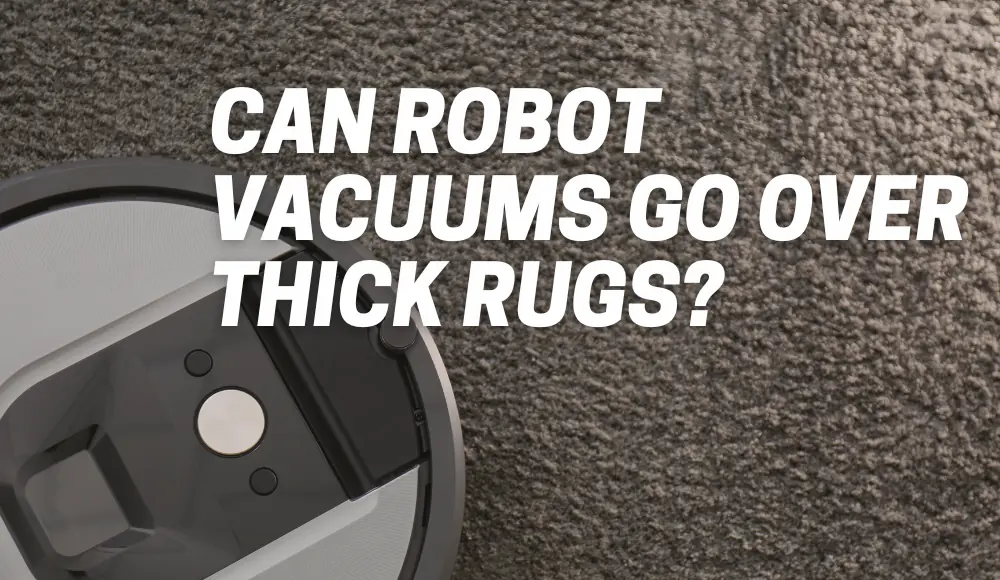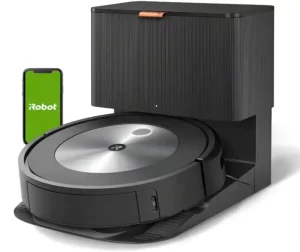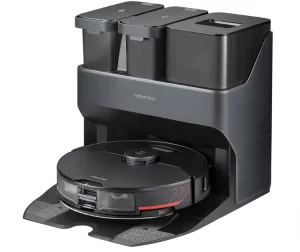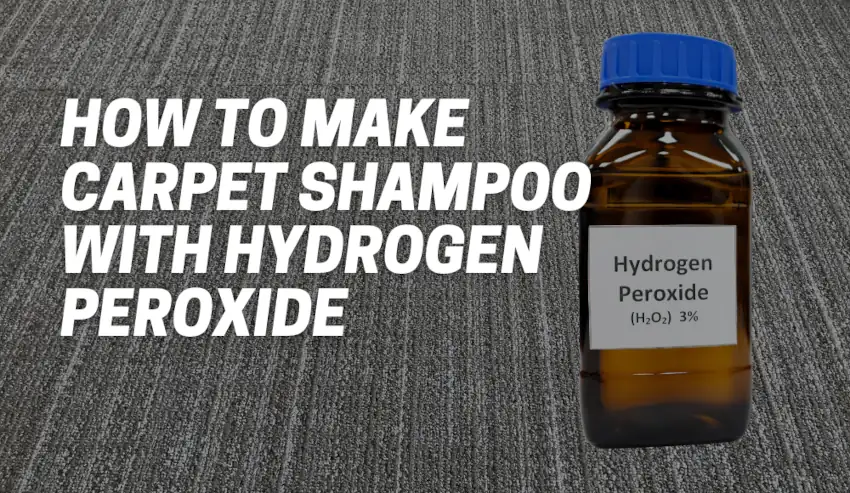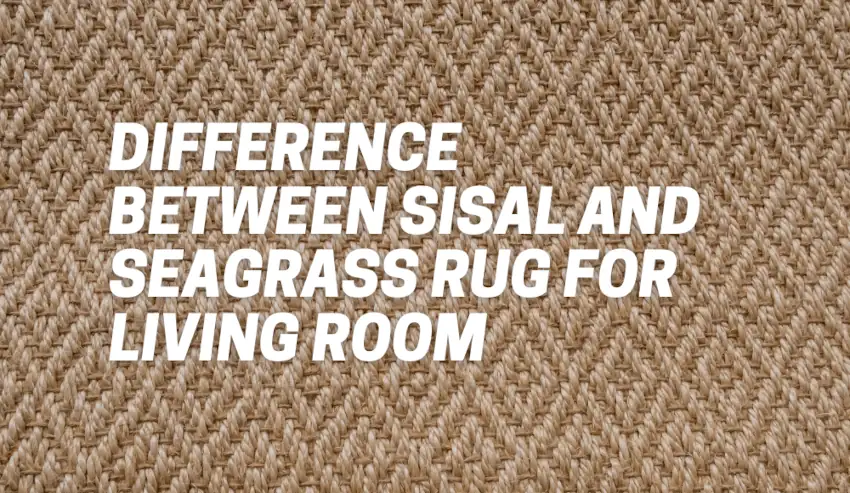Robot vacuums are a modern convenience that has revolutionized the way we clean our homes. These small, automated devices have the ability to move around our floors on their own, picking up dirt and debris as they go.
They’re especially handy for busy individuals who don’t have time to clean their homes regularly or individuals who simply want to make cleaning less of a hassle.
However, one common concern among consumers is whether these robot vacuums can handle thick rugs.
After all, if you have a plush carpet in your home, you want to make sure that it gets clean too.
That’s why it’s important to understand how robot vacuums work and what factors come into play when considering whether or not they can tackle thicker carpets.
What are Robot Vacuums?
First things first.
A robot vacuum is essentially a small, battery-powered machine that uses wheels and brushes or suction power to clean floors.
They operate using sensors that detect obstacles and guide them around furniture or other objects in their path. Some models even use advanced mapping technology to create maps of your home so they can navigate more efficiently.
Robot vacuums are designed with convenience in mind – they can be programmed to clean on a schedule so you don’t have to think about it.
Some models even connect to Wi-Fi networks allowing remote control through apps on your phone or tablet.
Do Robot Vacuums Get Stuck on Rugs at All?
Robot vacuums can occasionally get stuck on certain types of rugs, depending on their design and features. While modern robot vacuums are equipped with various sensors and advanced navigation algorithms to avoid obstacles, there are still some factors that can cause them to get stuck on rugs.
Here are a few reasons why a robot vacuum may have difficulty with rugs:
- Height and texture: Robot vacuums typically have a maximum clearance height, and if a rug is too thick or has a high pile, it may prevent the vacuum from moving smoothly or even cause it to get stuck. Similarly, certain rug textures, such as shaggy or long-pile rugs, can pose challenges for robot vacuums.
- Fringe or tassels: Rugs with fringe or tassels can create problems for robot vacuums. The vacuum’s brushes or wheels may get entangled in the fringe, leading to a halt or difficulty in movement.
- Transition between surfaces: Some robot vacuums struggle with transitioning from one type of surface to another, such as going from a hard floor to a rug or carpet. If the robot vacuum cannot detect the change in surface height accurately, it may have trouble navigating or become stuck.
- Lack of grip: If a rug has a slippery backing or is not firmly secured to the floor, a robot vacuum may have difficulty moving across it, potentially causing it to slide or get stuck.
While many robot vacuum models have improved their performance and navigation capabilities over time, it’s always a good idea to consider the characteristics of your rugs and check the specifications of the robot vacuum you are interested in to ensure it can handle the rugs in your home effectively.
In case you have missed specifying some characteristics for your robot vacuum before buying don’t wonder if it will ignore the rugs in your home.
Do Robot Vacuums Work on Thick Rugs?
The answer is both yes and no. It really depends on the specific model of the vacuum cleaner and the thickness of your rug.
If you have a low-pile rug with short fibers, most robot vacuums should be able to handle it without any issues at all.
However, if you have a high-pile rug with long fibers or shaggy materials like wool or silk, you may encounter some problems.
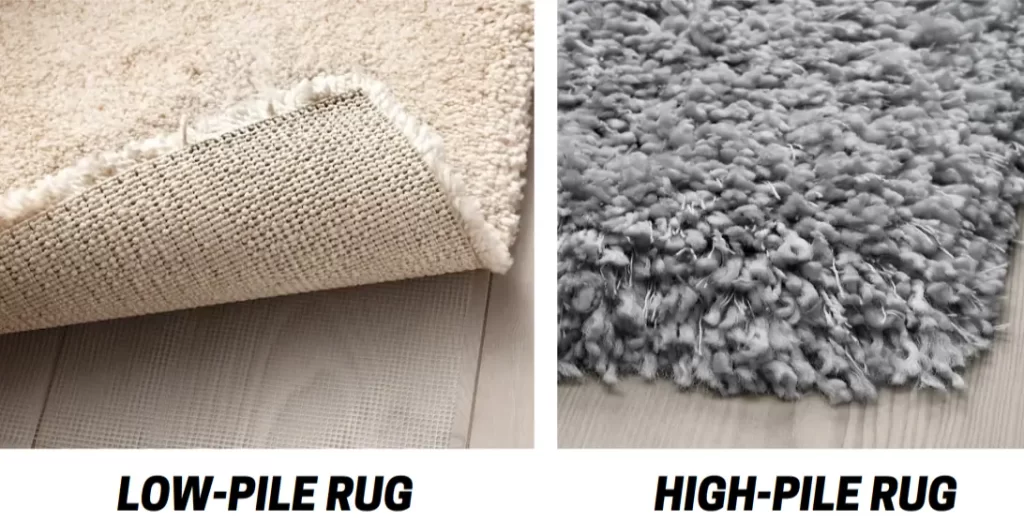
The longer fibers can get tangled up in the brushes, causing the robot vacuum to malfunction or stop working entirely.
Additionally, if your rug is too thick, it can cause an issue with suction power – the robot vacuum may struggle to pick up dirt and debris from the rug’s surface.
Whether or not a robot vacuum can clean a thick rug depends on several factors such as the type of rug and model of the vacuum cleaner.
Now that we’ve covered what robot vacuums are and their capabilities let’s dive deeper into whether they can handle thicker carpets.
The Rise of Robot Vacuums
Robot vacuums are the latest innovation in home cleaning technology.
These compact machines are designed to take care of everyday floor cleaning, so you don’t have to.
They use a combination of sensors and algorithms to navigate around your home, map out the best cleaning paths, and avoid obstacles along the way.
One of the biggest benefits of robot vacuums is their convenience.
With just a push of a button or a voice command, you can set them to clean your floors automatically – no need for you to get up from your couch or change into cleaning gear.
This means more time for yourself and less time spent on household chores.
Plus, most robot vacuums come with scheduling features that allow you to program them to clean at specific times or days when it suits you best.
So whether you’re at work or out running errands, you can come back home to a cleaner space without lifting a finger.
How Do Robot Vacuums Work?
Robot vacuums feature multiple components that work together seamlessly to ensure thorough floor cleaning. They are equipped with various sensors (such as cliff sensors and bump sensors) that allow them to navigate around objects and avoid falling down stairs or ledges.
Most robot vacuums also have spinning brushes attached underneath that sweep dirt and debris toward the suction inlet at the center of the machine.
Many models also include HEPA filters (high-efficiency particulate air filters) which trap tiny particles like pollen and dust mites.
To power it all, robot vacuums rely on rechargeable batteries that can provide several hours’ worth of cleaning per charge – depending on the model’s battery capacity and suction performance.
When their battery runs low during operation, most models will automatically return to their charging dock for recharging before resuming cleaning later.
Robot vacuums offer a convenient solution for keeping your floors clean without sacrificing your time and energy. They use smart technology to navigate and clean your home efficiently while allowing you to enjoy your free time.
Can Robot Vacuums Clean Thick Rugs?
The Battle Between Suction Power and Brush Roll Design
Robot vacuums have come a long way since they were first introduced to the market.
They are now more sophisticated and versatile, designed to handle various cleaning challenges, including cleaning thick carpets.
However, not all robot vacuums are created equal when it comes to cleaning thicker carpets.
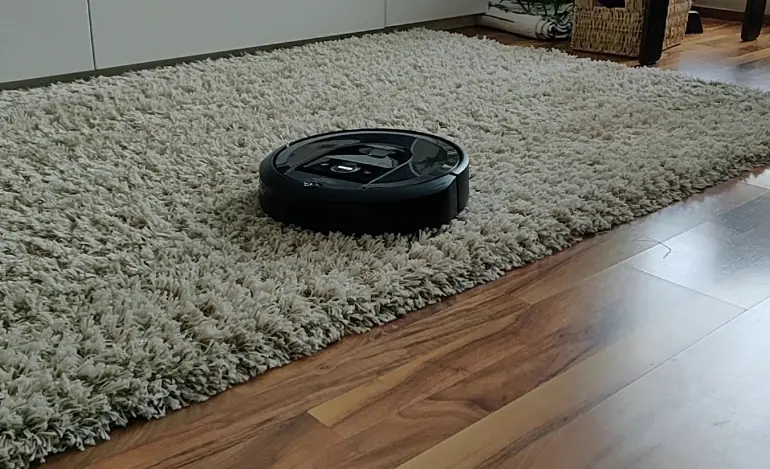
The ability of a robot vacuum to clean a thick rug depends on several factors, including suction power and brush roll design.
- Suction power is the force that enables a vacuum cleaner to pick up dirt and debris from the floor. Typically, the higher the suction power of a robot vacuum, the better its ability to clean thick carpets. Strong suction power ensures that even the deepest fibers of your rug are cleaned effectively.
- A powerful motor means that your robot vacuum picks up more dirt in every pass than one with weaker suction power.
- On top of this factor is brush roll design which plays an equally significant role in cleaning thicker carpets. The type of brush roll used by your robot vacuum determines how well it can agitate and loosen debris from deep within your carpet’s fibers. Some models feature powerful brush rolls specifically designed for heavier-duty applications like thicker carpets while others come equipped with adjustable height settings for their brushes which allow them to work efficiently on different carpet heights.
Designed Specifically for Thicker Carpets – Some Models Stand Out
If you’re looking for a robot vacuum that can handle thicker carpets effectively, you need to look for models that have been designed with this specific challenge in mind.
Some models come equipped with unique features such as automatic height adjustment and improved brush roll designs that enable them to perform better on thicker carpets than others.
What is the best robot vacuum for thick carpet?
One example of such models is iRobot Roomba’s i7+ and j7+ series which features an Auto-Adjust Cleaning Head capable of automatically adjusting its height to cater to different carpet heights.
This feature ensures that the vacuum cleaner maintains maximum contact with your carpet, making it easier to pick up dirt and debris effectively.
Can Roomba go over thick rugs?
Here is an example of how Roomba i7+ manages to clean a high-pile thick rug:
Additionally, the i7+ series comes with a high-efficiency filter that helps trap particles and allergens picked up from your thick rug.
Another example and the best overall robot vacuum for high-pile rugs and carpets is the Roborock S7 MaxV Ultra with its impressive dock station… and price tag. But, as you know, in most cases we have to pay for what we want to get.
When looking for a robot vacuum capable of cleaning thicker carpets effectively, you need to pay attention to suction power and brush roll design.
Models that have been specifically designed for this challenge are your best bet for getting thorough cleaning results on thicker rugs.
Otherwise, your little house-cleaning helper may get in a struggle with a thick rug.
—
Tips for Using a Robot Vacuum on Thick Rugs
Clear any obstacles and set boundaries
When it comes to using your robot vacuum on thicker carpets, it’s important to prepare the area before you start.
Clear away any obstacles or clutter that might interfere with the robot’s movement, and set up virtual boundaries if your model allows for it.
Virtual boundaries are like invisible walls that prevent your robot from going where you don’t want it to, which can be useful if you have specific areas you want the vacuum to avoid.
Choose a model with adjustable height settings
One of the most crucial aspects of cleaning thick rugs with a robot vacuum is choosing a model with adjustable height settings. This feature will allow you to adjust the height of your vacuum so that it can effectively clean different types of surfaces, including thicker carpets and rugs.
Some models even have sensors that detect changes in surface heights automatically, ensuring optimal cleaning performance.
Avoid overloading your robot vacuum
Another tip for using your robot vacuum on thicker carpets is to avoid overloading it. While these vacuums are designed to be convenient and efficient, they still have their limitations.
Overloading your robot with too much dirt or debris can cause its suction power to decrease over time or even damage its motor in extreme cases.
To ensure optimal performance, make sure you empty the dustbin regularly and perform routine maintenance on your machine.
By following these practical tips for using a robot vacuum on thicker carpets, you can ensure that your machine performs at its best while also protecting its longevity.
Whether you’re dealing with high-pile shag rugs or other types of thick carpets in your home or office space, there are models out there that can handle them effectively – as long as they’re used correctly.
The Pros and Cons of Using a Robot Vacuum on Thick Rugs
Advantages
Robot vacuums are a popular choice for their convenience and time-saving capabilities.
When it comes to cleaning thick carpets, a robot vacuum can still be a valuable tool. For one, they can save you the hassle of lugging around a heavy upright vacuum or having to manually spot-clean difficult areas.
With their small size and maneuverability, they can easily navigate between furniture legs and tight spaces.
Additionally, some models come with features specifically designed to handle thicker carpets.
These may include adjustable height settings or stronger suction power that can help pick up dirt and debris caught in deeper fibers. Some robot vacuums also have longer battery lives, which is useful when cleaning larger areas such as living rooms with thick rugs.
Disadvantages
While robot vacuums have their advantages, they may not always be the best option for cleaning thick rugs.
One potential drawback is that some models may struggle with deep pile carpeting since their brush rolls could get tangled up in the fibers or fail to pick up all dirt and debris.
Another limitation to consider is battery life – while some models offer longer run times ideal for larger spaces, others may require more frequent recharging if used extensively on thicker carpets.
Users should bear in mind that robot vacuums cannot replace regular deep cleaning from more powerful machines such as uprights or canisters. They are best suited as an additional tool for maintenance between deeper cleanings rather than being relied on solely for keeping your thick rugs clean.
Conclusion
It is possible for robot vacuums to clean thick rugs, but it depends on various factors.
The suction power and brush roll design of the vacuum are important considerations. Some models are specifically designed to handle thicker carpets, so it’s important to do research before making a purchase decision.
It’s also important to note that while robot vacuums can save time and make cleaning more convenient, they may not be as effective as traditional vacuums when it comes to cleaning thicker carpets.
It’s a good idea to regularly check the vacuum’s dustbin and brushes for any clogs or tangles, especially when using them on thicker carpets.
If you’re considering purchasing a robot vacuum for your home, make sure to take into account your specific needs and the type of flooring you have. Do some research and read product reviews before making a decision.
Remember that while robot vacuums can be helpful tools in keeping your home clean, they might not be suitable for everyone in every situation.
Overall, robot vacuums are an innovative tool that can help save time and make household chores easier.
With proper maintenance and use, they can effectively clean most types of flooring including thick rugs. So go ahead and invest in one if you’re looking for convenience!
